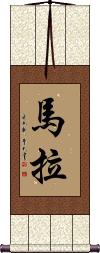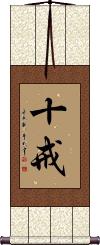Many custom options...
And formats...

The name Mala in Chinese / Japanese...
Buy a Mala calligraphy wall scroll here!
Personalize your custom “Mala” project by clicking the button next to your favorite “Mala” title below...
Mala
Mala
Ten Commandments
十戒 means Ten Commandments or Ten Precepts.
In the Buddhist context, these are prohibitions consisting of five commandments for the layman:
1. Not to destroy life 不殺生 Pāṇātipātāveramaṇi.
2. Not to steal 不倫盜 Adinnādānāver.
3. Not to commit adultery 不婬慾 Abrahmacaryaver.
4. Not to lie 不妄語 Musāvādāver.
5. Not to take intoxicating liquor 不飮酒 Suramereyya-Majjapamādaṭṭhānāver.
The ten commandments for the monk are the preceding five plus:
6. Not to eat food outside of regulated hours 不非時食 Vikāla-Bhojanāver.
7. Not to use garlands or perfumes 不著華鬘好香塗身 Mālā- Gandha-Vilepana-Dhāraṇa-Maṇḍana-Vibhūṣanaṭṭhānā.
8. Not to sleep on high or broad beds (chastity) 不坐高廣大牀 Uccāsayanā-Mahāsayanā.
9. Not to take part in singing, dancing, musical or theatrical performances 不歌舞倡伎不往觀聽 Nacca-Gīta-Vādita-Visūkadassanāver.
10. To refrain from acquiring uncoined or coined gold, or silver, or jewels 不得捉錢金銀寶物 Jātarūpa-Rajata-Paṭīggahaṇāver.
These original Buddhist commandments date back to about 2500 years ago. The English definitions above are followed by Chinese characters and original Pali pronunciation.
Under the Māhayāna Buddhism, these ten commands for the monk were changed, to accord with the new environment of the monk, to the following: not to kill, not to steal, to avoid all unchastity, not to lie, not to slander, not to insult, not to chatter, not to covet, not to give way to anger, to harbor no skepticism.
Not the results for Mala that you were looking for?
Below are some entries from our dictionary that may match your Mala search...
| Characters If shown, 2nd row is Simp. Chinese |
Pronunciation Romanization |
Simple Dictionary Definition |
十戒 see styles |
shí jiè shi2 jie4 shih chieh jukkai じゅっかい |
More info & calligraphy: Ten Commandments(1) (Buddhist term) the 10 precepts; (2) Ten Commandments; Decalogue; Decalog; (surname) Jukkai Śikṣāpada. The ten prohibitions (in Pāli form) consist of five commandments for the layman: (1) not to destroy life 不殺生 pāṇātipātāveramaṇi; (2) not to steal 不倫盜 adinnādānāver; (3) not to commit adultery 不婬慾 abrahmacaryaver.; (4) not to lie 不妄語musāvādāver.; (5) not to take intoxicating liquor 不飮酒 suramereyya-majjapamādaṭṭhānāver. Eight special commandments for laymen consist of the preceding five plus: (6) not to eat food out of regulated hours 不非時食 vikāla-bhojanāver.; (7) not to use garlands or perfumes 不著華鬘好香塗身 mālā- gandha-vilepana-dhāraṇa-maṇḍana-vibhūṣanaṭṭhānā; (8) not to sleep on high or broad beds (chastity) 不坐高廣大牀 uccāsayanā-mahāsayanā. The ten commandments for the monk are the preceding eight plus: (9) not to take part in singing, dancing, musical or theatrical performances, not to see or listen to such 不歌舞倡伎不往觀聽 nacca-gīta-vādita-visūkadassanāver.; (10) to refrain from acquiring uncoined or coined gold, or silver, or jewels 不得捉錢金銀寶物 jātarūpa-rajata-paṭīggahaṇāver. Under the Māhayāna these ten commands for the monk were changed, to accord with the new environment of the monk, to the following: not to kill, not to steal, to avoid all unchastity, not to lie, not to slander, not to insult, not to chatter, not to covet, not to give way to anger, to harbour no scepticism. |
マーラ see styles |
maara / mara マーラ |
More info & calligraphy: Marla |
垢 see styles |
gòu gou4 kou yoshimi よしみ |
dirt; disgrace {Buddh} (See 煩悩・2) klesha (polluting thoughts such as greed, hatred and delusion, which result in suffering); (personal name) Yoshimi mala. Dust, impurity, dregs; moral impurity; mental impurity. Whatever misleads or deludes the mind; illusion; defilement; the six forms are vexation, malevolence, hatred, flattery, wild talk, pride; the seven are desire, false views, doubt, presumption, arrogance, inertia, and meanness. |
悪意 see styles |
akui あくい |
(noun - becomes adjective with の) (1) ill will; spite; evil intention; malice; (noun - becomes adjective with の) (2) bad meaning; (3) {law} (See 善意・4) mala fides; bad faith; criminal intent to deceive; (4) {law} malice |
摩羅 摩罗 see styles |
mó luó mo2 luo2 mo lo mara まら |
(1) obstacle to Buddhist practice; (2) (vulgar) (kana only) penis māla, a wreath, garland, chaplet, headdress; also tr. as Māra, a huge fish, cf. 摩竭羅 makara. |
華鬘 华鬘 see styles |
huá mán hua2 man2 hua man keman けまん |
{Buddh} Buddhist decoration engraved with various motifs, often made from gilt copper (e.g. for adorning the inner shrine of a temple) kusuma-māla, a wreath, or chaplet of flowers. |
鴦掘 see styles |
yāng jué yang1 jue2 yang chüeh |
Aṅguli-māla |
麻辣 see styles |
má là ma2 la4 ma la maaraa / mara マーラー |
hot and numbing {food} mala (spicy and numbing seasoning) (chi: málà) |
麼攞 see styles |
mó luó mo2 luo2 mo lo |
mālā |
麽攞 see styles |
luó luo2 lo |
麽羅 mālā, a head-dress, wreath. |
マラ島 see styles |
maratou / marato マラとう |
(place-name) Mala (island) |
麻辣味 see styles |
maaraaaji; maaraawei / maraaji; marawe マーラーあじ; マーラーウェイ |
{food} mala sauce |
央掘摩羅 央掘摩罗 see styles |
yāng jué mó luó yang1 jue2 mo2 luo2 yang chüeh mo lo Ōkutsumara |
(央掘); 央仇魔羅; 央崛鬘; 盎崛利摩羅 (or 鴦崛利摩羅) (or 鴦窶利摩羅) Aṇgulimālya, Śivaitic fanatics who ' made assassination a religious act', and wore finger-bones as a chaplet. One who had assassinated 999, and was about to assassinate his mother for the thousandth, is said to have been then converted by the Buddha. |
悪意占有 see styles |
akuisenyuu / akuisenyu あくいせんゆう |
{law} (See 善意占有) mala fide possession |
鴦掘摩羅 see styles |
yāng jué mó luó yang1 jue2 mo2 luo2 yang chüeh mo lo |
Aṅguli-māla |
于遮那摩羅 于遮那摩罗 see styles |
yú zhēn à mó luó yu2 zhen1 a4 mo2 luo2 yü chen a mo lo Ushanamara |
Used in error for 干遮那摩羅. |
干遮那摩羅 干遮那摩罗 see styles |
gān zhēn à mó luó gan1 zhen1 a4 mo2 luo2 kan chen a mo lo Kanshanamara |
Kāñcana-mālā, a hair circlet or ornament of pure gold; name of the wife of Kuṇālā, noted for fidelity to her husband when he had been disgraced. |
不著香華鬘不香塗身 不着香华鬘不香涂身 see styles |
bù zhù xiāng huā mán bù xiāng tú shēn bu4 zhu4 xiang1 hua1 man2 bu4 xiang1 tu2 shen1 pu chu hsiang hua man pu hsiang t`u shen pu chu hsiang hua man pu hsiang tu shen fujaku kōkeman fukōzushin |
mālā-gandha-vilepana-dhāraṇa-maṇḍana-vibhūṣaṇasthānād vairamaṇī (virati). The eighth commandment against adorning the body with wreaths of fragrant fowers, or using fragrant unguents. |
The following table may be helpful for those studying Chinese or Japanese...
| Title | Characters | Romaji (Romanized Japanese) | Various forms of Romanized Chinese | |
| Mala | 馬拉 马拉 | mǎ lā / ma3 la1 / ma la / mala | ma | |
| Mala | マラ | mara | ||
| Ten Commandments | 十戒 | jukkai / jukai | shí jiè / shi2 jie4 / shi jie / shijie | shih chieh / shihchieh |
| In some entries above you will see that characters have different versions above and below a line. In these cases, the characters above the line are Traditional Chinese, while the ones below are Simplified Chinese. | ||||
Successful Chinese Character and Japanese Kanji calligraphy searches within the last few hours...






